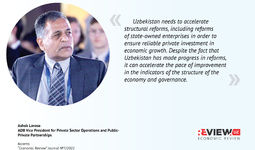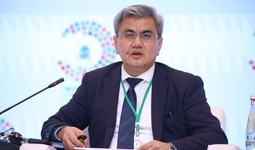Uzbekistan has made a promising start integrating PPPs into its infrastructure development agenda. Bold policies and efficient project delivery are needed to take the country’s ambitious program to the next level.
A key theme of Uzbekistan’s impressive economic revitalization since 2017 has been to accelerate infrastructure development through private sector participation. This led to an ambitious public-private partnership program that included passing the first Public-Private Partnership (PPP) Law, creating a dedicated PPP agency, and requiring line agencies to promote PPPs for key projects.
In 2021 more than 40 large and medium projects using PPP are expected to commence, sending an unequivocal signal to government agencies and the international market that PPPs are here to stay. The program achieved several milestones in 2020. In January 2021, a long-awaited amendment to the PPP Law was approved and signed. The first transactions prompted by the program are coming to close, paving the way for more in sectors including renewable energy, health, and transport.
The newly amended PPP Law is a product of year-long dialogue between the government and market participants, international advisors, and development finance institutions. It is based on international market standards for a fast-growing economy and focuses on facilitating foreign investment, including through a streamlined and transparent tender process, balanced foreign exchange risk protection, and international arbitration. This is providing momentum for forays into new sectors, the creation of contract templates, and building PPP capacity to deliver more projects in years to come.
Through bold policies and project delivery, Uzbekistan can forge a world-class PPP program that delivers the infrastructure needed for continued strong economic growth.
The PPP program is at a pivotal point, a proven concept ready to be expanded and brought to market. Sustainability, scope, and scale are the key themes. Having worked alongside key policymakers and project enablers in government since the program’s inception, we can identify six areas needing policy attention in 2021.
1. Integrate PPPs at a national infrastructure planning level. PPP is a procurement tool and should be viewed as one of many possible ways for government to achieve infrastructure objectives. To make PPPs part of the overall planning mechanism, a few steps need to be taken. First, capacity building at line agencies to generate interest and awareness of PPPs and to know when to apply them. A key step is to develop an appreciation for whole-of-life costing, which for many Uzbek line agencies is a departure from traditional costing. Second, a policy framework and project screening mechanism to decide when a project should be done as a PPP, including a consistent value-for-money methodology applied uniformly. Third, training at the central planning agency to ensure that the mechanisms are properly applied.
2. Carefully expand use of availability payments. Availability payment-based PPPs are well accepted worldwide, and several sectors such as renewable power generation and social infrastructure have relied on them. The need to create a scalable system for availability payment-based projects is exacerbated by the pandemic’s impact particularly on transport infrastructure, with fewer bidders and lenders willing to take market risk. Agencies should recognize the value of this modality, particularly its focus on quality of operations and service delivery. They should also implement a system to monitor and manage its fiscal liabilities in the medium term, and as use of availability payments scales up.
3. Establish a project development fund. Project preparation is one of the keys to successful PPP implementation, but the costs of hiring specialist consultants to provide feasibility assessments and transaction advisory can be prohibitive for government agencies. A replenishable project development fund would allow the government to retain transaction advisors to prepare and tender the project, reimbursed through success fees from the winning bidder. It would scale up the program by enabling a larger number of projects to be brought to market at once, and allow faster hiring of consultants through a panel of commercial transaction advisors that can be drawn on at any time.
4. Plan for post-close project implementation. While achieving financial close on a project is exciting, for the “newlywed” public and private partners this is just the beginning of a multi-decade concession period. It is critical for the public partner to set up a well-staffed project monitoring unit, develop processes and manuals on how to fulfill its role as public partner, and build the internal capacity for this new role. Agencies which currently have projects in tender should start thinking about their plan now, with the help of their development partners.
5. Improve local currency liquidity and enable local banks to participate in PPPs. Uzbekistan suffers from low local currency liquidity for infrastructure projects largely because of a mismatch between the tenor of a project finance loan and local banks’ deposit base. To alleviate this, the government could use a strategy that has proven effective in Bangladesh: create a non-bank financial intermediary capitalized by government and/or other interested investors able to provide local currency project financing.
6. Bring Uzbekistan to the world. With the amended law passed, several projects in tender, and a robust pipeline of future projects, now is the time to promote Uzbekistan’s PPP program globally. With major conferences moving online, opportunities are greater than ever. International media coverage should be maximized. As tenders for some of ADB’s recent projects have shown, leading companies from all over the world are interested in bidding for projects across multiple sectors.
Uzbekistan’s rapid economic development has opened space for ADB to enhance its PPP support. We’ve helped to build capacity at 16 government agencies, and advised the government on the PPP law amendment and other policies. Our transaction advisory support across 5 sectors aims to not only close projects but develop contract templates for future use. To improve project finance in early deals, we work with public sector clients to make creative use of financial products such as local currency liquidity or sovereign guarantees.
A programmatic and interconnected approach is necessary: Institutional development has to be driven by broad based capacity building, legislative changes should be based on lessons learned from transactions, and the first transactions will require development bank financing.
Uzbekistan has made a promising start towards integrating PPPs as a valuable tool in its infrastructure development agenda. Through bold policies and project delivery, Uzbekistan can forge a world-class PPP program that delivers the infrastructure needed for continued strong economic growth.
ADB Deputy Director in Uzbekistan Enrico Pinali
Pratish Haladi, ADB Chief PPP Specialist





















leave a comment